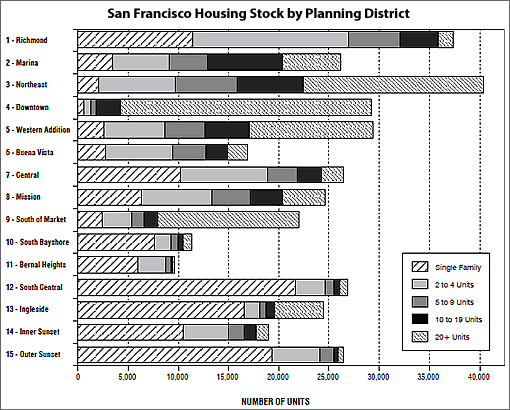
The Planning Commission will get their first peek at the Planning Department’s latest Housing Inventory report this afternoon, you get it this morning.
With 372,831 total housing units in San Francisco, a third of which are single-family homes and only a quarter of which are in buildings with over 20 units, total new housing production in 2011 totaled 418 units, the lowest production since 1993 and versus an average of 1,890 units per year from 2000-2010.
In addition, 149 units were lost through demolition, merger or the removal of illegal units in 2011 for a net gain of only 269 units last year.
Building permits were pulled for new 1,998 units in 2011, units which should be online within two to three years. And while 57 proposed projects totally 15,060 units were entitled in 2011, that includes 7,800 units on Treasure Island and 5,680 units in Park-Merced, projects which have timelines measured in decades, not years.
Since 2007, a total of 10,438 housing units were constructed in San Francisco, 88 percent of which were in buildings of 20 units or more. Since the year 2000, 24,519 net new units have been built.
A total of 51 market rate units were completed in 2011.
I was looking to see how many of the 1200 units permitted in 2010 were market rate but didn’t find it. Those are the units that will probably come to market next.
What a ridiculously low number.
A city of mid 800k people only built 51 market rate units in one year.
Excellent. Keep up the good work NIMBYs. My property value thanks you.
Yeah, too few to say the least. But here is why. Construction lending was nowhere to be found in 2009-2010.
Have to agree with anon1 on this one. It’ll be a shame if a false narrative develops at the Planning Commission meeting that somehow San Francisco needs to loosen up regulations because so few units are being built. Loosening up regulations might be a good idea on the merits, but there are reasons other than regulations why so few units are being built that are out of the control of The City.
It might well be the case that one possible explanation takes over as “THE CAUSE” of the construction falloff because data on other possible explanations isn’t available. How would one go about showing that construction lending fell off a cliff in 2009? You would have had to have done the same survey of lenders in 2007, 2008, 2009 and so on so you could compare the results.
I don’t know if The Fed provides a comprehensive report on regional construction lending, but if they do, that would be interesting to look at.
This is really interesting stuff editor. Thanks for the info.
Brahma,
I would look at it the other way,
I don’t see the city changing it’s policies at all. It will remain a long, slow process to build in the city. If fact it keeps getting longer and longer.
So in the next few years we will have the new construction from the 1200 units permitted in 2010, and the 1990 units in 2011.
So we are going to have something like 2400 market rate units in the next couple of years IF those projects have funding.
I for one am never going to build residential units in San Francisco again – the process is too painful to make it enjoyable and the profit margin so thin (15%+ permit costs/fees on my last project) that I can’t justify it to my bank. I’m building/investing outside the City these days.
Bob, I thought 15% is pretty decent, but perhaps it’s different for Builders. What would be the minimal return required? Thanks.
@jack: maybe I should have been clearer, the City permit costs and fees on my last project were over 15% of the total construction cost. That’s way out of line. And then they have the gall to say that that 15% should be considered part of the Prop 13 basis.
Got it. Thanks for the clarification. Yikes, the permits are indeed expensive.